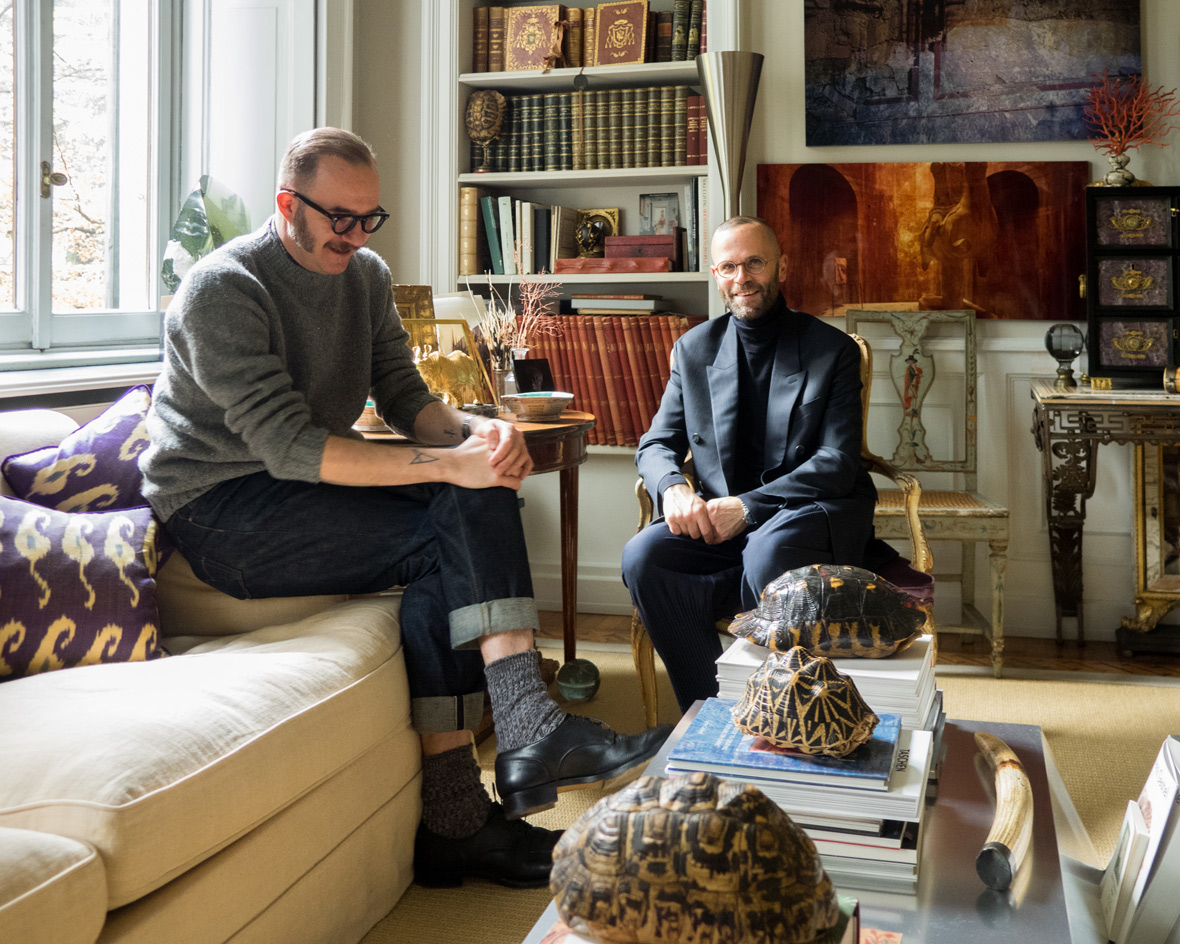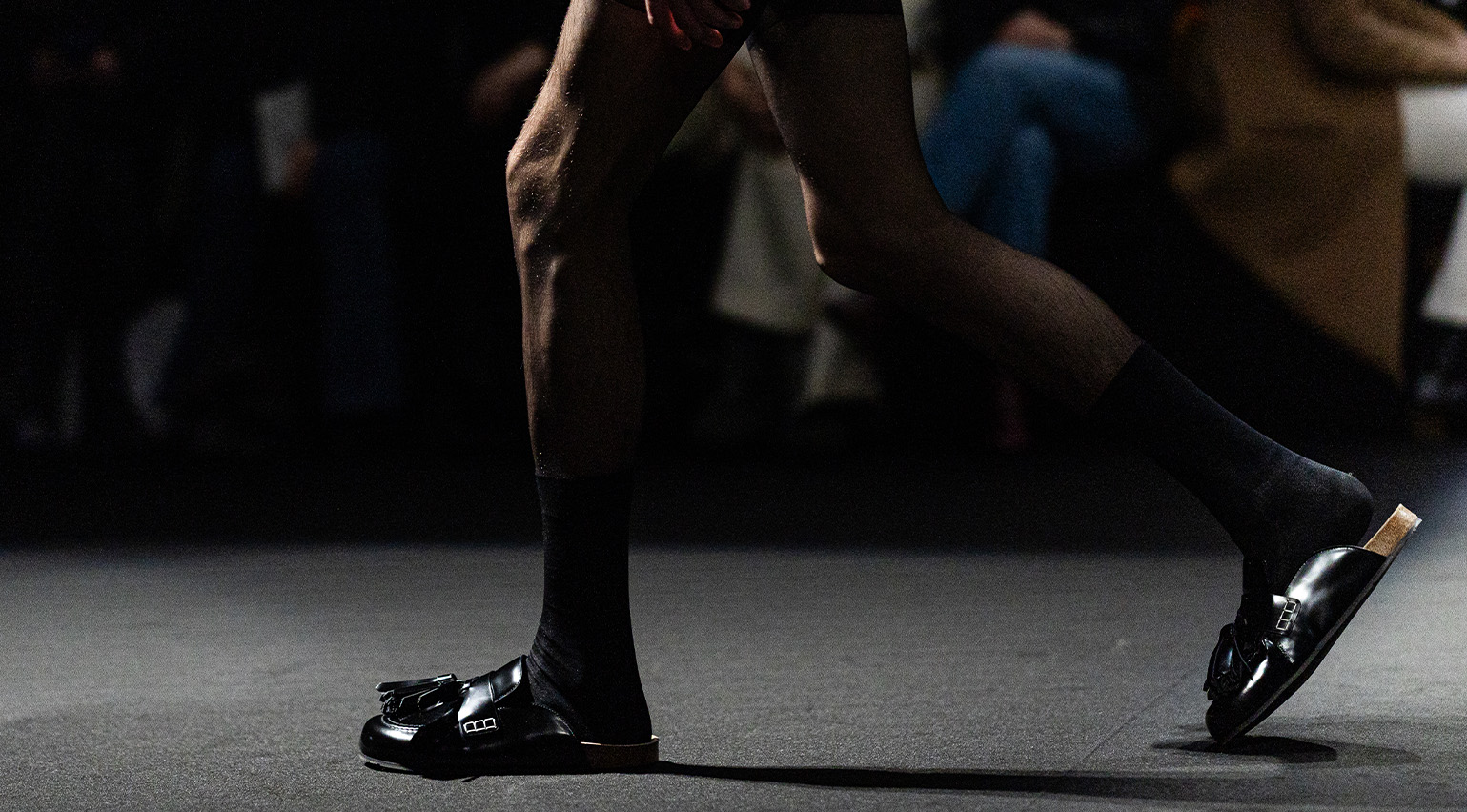Santoni’s Marco Zanini on plotting a small revolution at Piero Portaluppi’s home in Milan

‘The smallest things are always the most precious,’ says Marco Zanini. He is used to thinking big, engineering a string of successful brand relaunches, but in late 2016, Zanini downsized to design for artisanal shoemaker Santoni.
On a sunless winter day, he arrives at Milan’s Casa degli Atellani – a Renaissance-era city landmark where Leonardo lived while painting The Last Supper – and opens the door to the whimsically deco apartment of the late architect Piero Portaluppi, which served as the inspiration for Zanini’s newest collection. Portaluppi was a key figure of early 20th-century Milan, and his style became part of the city’s fabric in buildings such as Palazzo Crespi, Villa Necchi and the Liberty-influenced renovation of Casa degli Atellani.
Zanini, a remarkably tall man, passes through Portaluppi’s foyer, a room frescoed like an arboretum with fan palms, laurel, ivy and cactus, and takes a seat in the living room. ‘Small means precise. Small means agile,’ he continues, bending his knees sharply to perch on a petite ivory couch. ‘Small was the very idea that gave birth to this project.’
The Milan-born designer, formerly creative director of Halston, Rochas and Schiaparelli, and an alumnus of Versace and Dolce & Gabbana, turned his back on Paris and New York for a home-town brand.
At Santoni, Zanini’s purview has been the introduction of a carefully considered handful of designs – the top tier of the company’s footwear offerings, but also its first lines of men’s and women’s apparel, a pared-down capsule collection of timeless wardrobe essentials he calls Edited.
‘The beauty of this project is its reduced dimensions. Being limited in scale makes the work more dynamic and autonomous than at giant corporations,’ he says, rolling his eyes skyward at the thought of past frustrations. ‘Now I’m free of certain deadlines. And I’m not contending with 500 cooks in the kitchen.’

The architect’s home inspired the latest edition of Edited.
‘Less is better,’ agrees Angelo Flaccavento, fashion journalist and Zanini’s collaborator on the Edited project. ‘This project is different,’ he says. At a time when designers complain of the fashion industry’s cyclical strictures and a ceaseless pressure to produce, the limited scale of the Edited collection allows the pair time to contemplate and experiment.
At Santoni, Zanini kicks off each collection not with sketches but with a visual and verbal concept, that becomes a book when the clothing collection is complete. ‘Recounting a collection this way reveals Marco’s ideas in designing it, with his universe of references condensed into a jacket or a dress,’ says Flaccavento. ‘I could never design clothes,’ he continues, ‘but it’s important to have not just a visual person but a verbal person. And to be a curator, or to be a journalist, is the same mindset because the starting point is analysis.’ For Edited Trip, the duo also collaborated wth Marco Cendron, creative director and founder of the Milan-based studio Pomo, who art directed the publication. ‘Today we’re drowning in products that are mostly pointless,’ Flaccavento adds. ‘This project is different.’
The latest outing of Edited has drawn on Portaluppi’s home, and the book features images of his kaleidoscopic marble collection that still lines wood shelves in the living room (the 1,500 little marble slabs, all cut to the same size, were assembled by a young geologist in Rome in the mid-19th century, who trawled the city’s archaeological sites). Architecture lasts. Marble lasts. To relay the story of the clothes with these images is a rejection of today’s over-evanescent fashion world, Zanini argues. The hardbound volume is filled with quasi-psychedelic close-ups of stones: the blood-red veins of a rosy marble and the painterly amber rings of a fossilised wood, interspersed with very occasional coolly moody images of the collection.
It’s understatement as a communication tool, but then Zanini is motivated by rejection as much as creation, having traded glitzier opportunities for the chance to create exactly what he wants: ‘an edit of things that don’t change every six months, designed to accompany the wearer in the long term’, as he explains. There are no extraneous details, no wild cards in this soft-spoken, cerebral collection; only finely wrought basics rendered in his signature subdued palette. In an industry shackled by fast-paced production and almost instant irrelevance, it’s the brave designer who abandons the limelight to create what can endure.
As originally featured in the March 2018 issue of Wallpaper* (W*228)

Small marble slabs – trawled from Rome’s key archeological sites – line Portaluppi’s Milan apartment

Pages from Edited Trip.
INFORMATION
For more information, visit the Santoni website and the Pomo website
Wallpaper* Newsletter
Receive our daily digest of inspiration, escapism and design stories from around the world direct to your inbox.
-
 The Subaru Forester is the definition of unpretentious automotive design
The Subaru Forester is the definition of unpretentious automotive designIt’s not exactly king of the crossovers, but the Subaru Forester e-Boxer is reliable, practical and great for keeping a low profile
By Jonathan Bell
-
 Sotheby’s is auctioning a rare Frank Lloyd Wright lamp – and it could fetch $5 million
Sotheby’s is auctioning a rare Frank Lloyd Wright lamp – and it could fetch $5 millionThe architect's ‘Double-Pedestal’ lamp, which was designed for the Dana House in 1903, is hitting the auction block 13 May at Sotheby's.
By Anna Solomon
-
 Naoto Fukasawa sparks children’s imaginations with play sculptures
Naoto Fukasawa sparks children’s imaginations with play sculpturesThe Japanese designer creates an intuitive series of bold play sculptures, designed to spark children’s desire to play without thinking
By Danielle Demetriou
-
 ‘He made something not merely popular, but the rage’: unpacking Elio Fiorucci’s fabulous fashion legacy
‘He made something not merely popular, but the rage’: unpacking Elio Fiorucci’s fabulous fashion legacyAn expansive new retrospective at Triennale Milano explores the colourful life and work of Elio Fiorucci, who is synonymous with 1970s hedonism and glamour
By Zoe Whitfield
-
 Why the slipper is set to be this season’s definitive men’s shoe
Why the slipper is set to be this season’s definitive men’s shoeWallpaper* fashion features editor Jack Moss unpacks the rise of the men’s slipper, which looks set to become this season’s most ubiquitous shoe. Plus, five styles to channel the slipper’s louche elegance in your own wardrobe
By Jack Moss
-
 How fashion designer Ilenia Durazzi designed her ‘elegant, rigorous’ Milanese studio – all the way down to the furniture
How fashion designer Ilenia Durazzi designed her ‘elegant, rigorous’ Milanese studio – all the way down to the furnitureIlenia Durazzi of Durazzi Milano tells Wallpaper* the story behind her new Milanese studio, a labour of love built entirely to her exacting design
By Jack Moss
-
 ‘What does a Luca Faloni jacket look like?’: this suede bomber marks the brand’s first foray into outerwear
‘What does a Luca Faloni jacket look like?’: this suede bomber marks the brand’s first foray into outerwear‘Made for years to come’, this lightweight bomber marks Luca Faloni’s entry into outerwear and encapsulates the label’s provenance-focused approach
By Jack Moss
-
 ‘There are no shortcuts’: Ten years of Hereu, the cult Spanish shoe brand where craft is front and centre
‘There are no shortcuts’: Ten years of Hereu, the cult Spanish shoe brand where craft is front and centreDal Chodha visits Barcelona-based shoe and accessory brand Hereu as it reaches a milestone decade in business
By Dal Chodha
-
 Milan Fashion Week S/S 2025 highlights: Dolce & Gabbana to Bottega Veneta
Milan Fashion Week S/S 2025 highlights: Dolce & Gabbana to Bottega VenetaWallpaper* fashion features editor Jack Moss selects the best of Milan Fashion Week S/S 2025, from Dolce & Gabbana’s homage to Madonna to childlike wonder at Bottega Veneta
By Jack Moss
-
 Rovi Lucca is the Milanese label creating ‘elevated workwear for garden lovers’
Rovi Lucca is the Milanese label creating ‘elevated workwear for garden lovers’Rooted in Italian craft, Bradley Seymour and Fabrizio Taliani’s horticulturally inspired Rovi Lucca finds inspiration in the gardens of Lucca, Tuscany
By Zoe Whitfield
-
 Luca Magliano takes Wallpaper* on a tour Bologna, the home of his non-conformist fashion label
Luca Magliano takes Wallpaper* on a tour Bologna, the home of his non-conformist fashion labelLuca Magliano gives Wallpaper* an insider’s guide to Bologna, Italy, the lifeblood of his on-the-rise label – from a museum of queer history to a mystical cemetery (and plenty of gelato)
By Jack Moss